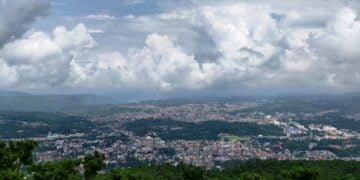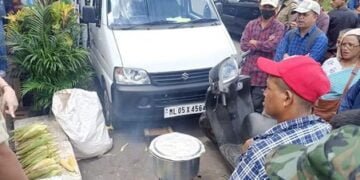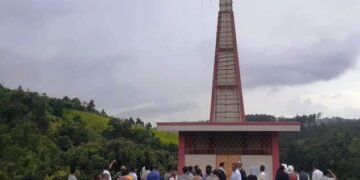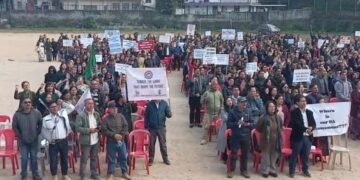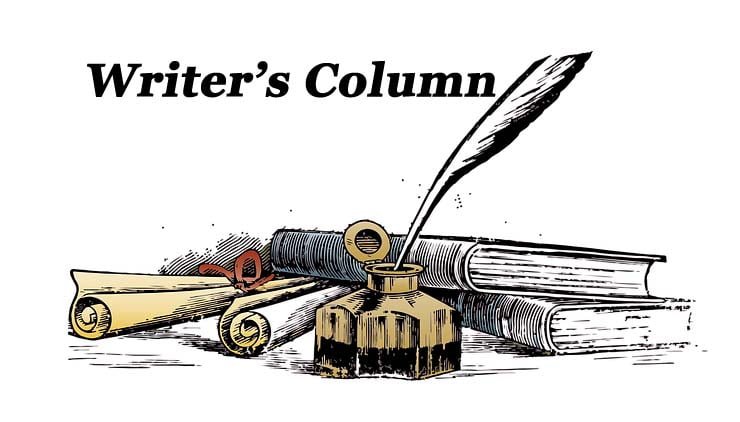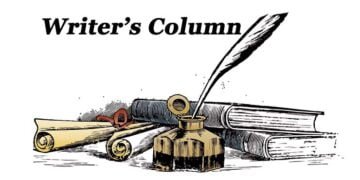By Saunak Mookerjee
Siraj ud Daulah succeeded to the throne after his maternal grandfather, Nawab Alivardi Khan, passed away in 1756. When he became the Nawab of Bengal, Bihar, and Orissa, Mir Jafar Ali Khan, Alivardi’s army commander-in-chief, was his onlyterrifyingfoe. This was because of his mature age, wartime experience, official position and strength.
Mir Jafar arrived in India as a penniless adventurer, just like his master, but he quickly proved his worth to Nawab Alivardi Khan, who gave him the hand of his half-sister, Shah Khanam, and gradually elevated him to the position of Bakhshi, or Paymaster-General. Although the literal meaning of Bakshi is Paymaster-General, it is interpreted as Captain General of the forces.
Mir was known to have gained an undeserved reputation for his bravery by the rapid march that allowed him to rescue Saulat Jang near Cuttack. (Saulat Jang was appointed as the governor of Purnia by his father-in-law Alivardi Khan. Saulat Jang was better known as the father of Shaukat Jang. Many historians inform that on the eve of Alivardi’s death, Siraj and Shaukat stood face to face as rivals for the throne of Bihar, Bengal and Orissa)
Jafar was also known for making bold decisions. For example, he was dispatched to fight the Marathas in Medinipur but returned abruptly to Burdwan. The soldiers lacked faith in a commander with such a reputation. Another bold action was his plot to usurp and assassinate Alivardi, who had propelled him from the dust to second place in the empire. The reasoning for this action was that if Alivardi could assassinate his patron Shuja-ud-Din’s heir and steal the throne, Jafar Ali had the same moral right to do so.
As a result, when Siraj succeeded to the throne, he changed the officers, appointing his own loyalists to important positions. Siraj saw Mir Jafar as a selfish traitor and eventually removed him from the supreme command of the army (bakhshi), appointing the valiant and faithful Mir Madan. Another dependable and talented officer was Mohan Lal, a Kashmiri whom he had appointed as Peshkar of his diwan khanah, with the title Maharajah and a degree of authority that effectively elevated him to the position of prime minister. Mohan Lal was wellknown for his involvement in the war of Manihari, in which he marched with SirajudDaulah’s forces carrying red flags and won the war by killing Shaukat Jang.
However, some historians believe that prior to the Battle of Plassey, when news arrived that Robert Clive, Lieutenant-Colonel of the British army, along with Sabit Jang had set out for the capital of Bengal with a party of English soldiers, Siraj ud Daulah reinstated Mir Jafar and Khadim Husain Khan to their former positions and appointed Shaikh Khairullah Khidmatgar as his intermediary for reconciling them. To that end, a document was written and signed by the two sardars before being presented to the Nawab. During that time, Mir Madan advised the Nawab not to expect any decent service from the sardars or the chiefs.In truth, before and during Siraj’s reign, sardars were vilified for being enticed with money, lands, and wealth in exchange for joining and fighting against the sovereign by swearing an oath and making solemn pledges of alliance. He also stated that the presence of these two in the camp would be a source of diversion and concern for the loyal generals, as both were expected to commit betrayal. However, Siraj udDaulh ignored Mir Madan and moved to battling the English.
The British wanted to depose Siraj udDaulah and install a friendly Nawab so that they could powerfully build their defense in case they are attacked by a strong French force from the Deccan led by a general of the rank of Marquis de Bussy’s capacity, with the goal of conquering Bengal and restoring French power. The British had an advantage since Siraj’s reputation was tarnished as a result of his activities, which included mistreating important members of his administration and harassing his people.
As a result, there was a yearning for revolution inside his regime. The top members of the administrations, who had been ousted from office and humiliated, plotted to overthrow him, believing that the British were the only authority capable of delivering the country from the dictator Siraj.
Mir Madan and Khwaja Abdul Hadi Khan were aware that the British had surpassed the point of moderation, and they were eager to seize the nation. Mir Madan frequently exhorted the Nawab to attention to his royal responsibilities, the control of administration, the safety and prosperity of the people, and proper planning with great care and energy. Mir Madan, Nawab’s confidant, proposed that Mir Jafar be killed first since he had a deceitful mentality. However, the Nawab rejected this suggestion as well. Whereas, the British had taken numerous precautions for the upcoming battle at Plassey following the blows they faced when Calcutta was captured by Nawab Siraj ud Daulah. Numerous historians inform that on 13th June 1757, Clive started his march for the Nawab’s capital, with an army of 3000 men, of whom 800 were Europeans and the remaining were sepoys and half caste gunners. Clive who was eager to overthrow Nawab Siraj udDaulah was also anxious about the uncertain future. Even ten days prior to the battle, Robert Clive had just received bare promises from Mir Jafar. The entire mission seemedperilous because Clive was putting at risk the fortunes of Company on the bare word of Mir Jafar, who was a traitor to his own sovereign.On the 19th, he ordered a detachment under Major Eyre Coote to seize the Katwa fort, which the enemy had left as he approached. Clive’s camp was an 800-yard-by-300-yard mango grove known as the Lakshabagh (literal meaning: park of a hundred thousand trees), with the trees planted in straight rows and bordered on four sides by an earthen embankment that functioned as a defense. This location was chosen so that the thick branches might shield them from the enemy’s overhead fire. The northwestern corner of the grove was barely 150 yards from the Ganges, which covered its left flank, while the settlement of Plassey, 1100 yards behind, protected the rear. About 200 yards north of the grove, on the bank of the river, stood the Nawab’s hunting lodge, a brick building surrounded by masonry walls that Clive immediately occupied and whose roof served as a good observation post.
On the day of the Battle of Plassey on June 23, 1757, the forces headed by Mir Madan are claimed to have outnumbered the British. Mir Madan and Raja Mohan Lal are reported to have been positioned in the van, with Nawab Siraj ud Daulah remaining in the back to assist them. Indeed, the most effective element of Nawab’s army fighting for Siraj ud Daulah was headed by Mir Madan, Mohan Lal Kashmiri, and other honorable individuals. The Nawab’s army were led by five thousand handpicked Mughal horsemen and seven thousand infantry (Rajputs and Pathans), as well as two heavy artillery, and they were the only ones involved in the conflict that day. In contrast, Clive’s army had Europeans in the center, with four battalions led by Archibald Grant, Majors Killpatrick, Gaupp, and Captain Eyre Coote. Soldiers were divided into two divisions on each side, with three six-pounder cannons on the European flanks, slightly ahead of the troops. They were drawn up in the plain in front of the mango grove in a line approximately 600 yards long, east to west, with the river to their left.
Initially, cooperation between the French and the Nawab’s troops appeared promising. The Nawab’s forces made a most impressive show, as after issuing from their camp they drew up on the plain north east of the village of Plassey, in a vast are, over two miles in length, almost surrounding the English army and threatening to drive it into the Ganges which flowed on its left. They totalled about fifty thousand troops on horseback and foot, but only around twelve thousand men, comprising the vanguard or right wing, and twelve pieces of artillery participated in the conflict. The Nawab’s infantry had little or no discipline, and the majority of the army was armed with arrows, pikes, swords, or bows. His cavalry was of exceptional quality, with both soldiers and horses of northern descent and enormous stature.
Siraj possessed 53 pieces of artillery, the majority of which were large calibres and eighteen-pounders. These were erected on massive platforms with wheels and pulled by forty or fifty yokes of muscular oxen, aided by elephants. When there was a problem, an elephant would accompany each carriage and push it ahead with its head. These platforms transported not just cannons and carriages, but also ammunition, supplies, and gunners. Their cannon moved along and in front of their main body, obscuring their whole front with the bullocks that dragged them. This massive, multicolored mob of soldiers, elephants, and horses was flanked by a thin line of red coats and white cross belts, about 600 feet long, with nine hundred and fifty white faces in the center and two thousand and one hundred faces in the wings, as well as six extremely light weapons in front.
The French commenced fire with remarkable accuracy from a large tank around two hundred yards from the English line. They had killed one grenadier and injured another from the Bengal European regiment. This signalled that the whole attacking army should engage in the operation. Nawab launched a massive cannonade from the outset, the most of which was poorly aimed. The English soon retaliated with their six-pounder guns, which had an impact on the enemy’s thick masses and held them back, but were too short in range to silence the Nawab’s artillery. Within half an hour, the English had lost 30 men, and Robert Clivewithdrew his soldiers behind the grove, where the trees provided cover overhead and the embankment in front.The British contingent of Clive’s army included 950 European soldiers and 150 artillerymen, as well as 57 sailors and a handful of laskars to help. His Indian soldiers consisted of 2100 sepoys, all infantry, made up of people from Madras and Bengal Infantry (first battalion), also known as the Lal Paltan. Following the recovery of Calcutta, such an action was carried out by enrolling troops from Doab, Rohilkhand, Bihar, and Oudh, as well as Brahmans, Rohillas, Jats, Pathans, and Rajputs, but the bulk of the men were Muslims, many of whom were disbanded Indian princes’ soldiers.
Meanwhile, because of the rains on the day of the battle at Plassey, the Nawab’s artillery was rendered ineffective because of the rain dampening their uncovered gunpowder, whereas the British had carefully stored their powder. Several enemy gunners were killed and several serious explosions occurred among their carelessly exposed munitions as a result of the smart and accurate fire of the English guns from the embrasures in the mangrove gun wall.However, the British guns’ quick discharge of grape shot from close range wreaked havoc on the oncoming Bengal cavalry. Mir Madan, Bahadur Ali Khan, Mohan Lal’s son-in-law and commander of the Bahalia musketeers, Nauwe Singh Hazari (captain of artillery), and a few other high officers continued to advance in their efforts to defeat the British. The advance was checked, and the cavalry turned their faces toward their entrenchment. Mir Madan marched ahead, certain that his sheer numbers would overpower the English. He came to the conclusion that rain had also rendered their firearms unusable.
But alas, Mir Madan, who worked hard to get to the front, was hit in the stomach by a cannonball and died.The accuracy with which the English cannon shot from just 200 yards away depressed the morale of Nawab’s forces, who now lacked a great leader to guide them. Furthermore, the earth beneath was wet because of the rainfall. Their horses floundered in the mud, and the ungainly wheels of their draught oxen refused to move under the lash.This caused the Nawab’s forces to withdraw from the battlefield and gradually retreat to their camp.According to some reports by French, save for about 50 Europeans with Monsieur Sinfray, the French artillery officer, and two or three chiefs who led cavalry, the rest of the army remained with folded hands or just hinted that they were on Sirajud Daulah’s side. Fear gripped the entire army following the death of Mir Madan. Except for the vanguard led by Mir Madan and Mohan Lal and its 12 guns, the rest of the Nawab’s artillery fired no shorts during the day.
Mir Jafar, Durlabh Ram, and Yar Lutf, as planned by the conspirators, did not fire a single shot that day, allowing Clive’s force to continue volley firing with precision and velocity unknown to Siraj’s army.When Siraj udDaulah learned of Mir Madan’s death, he summoned Mir Jafar to his tent and laid his turban at his feet, appealing to his allegiance. He prayed to Mir Jafarfor his honour. In fact, it is reported that Mir Jafar hesitated to execute Siraj because of the presence of loyal men, with Mir Madan serving as their head on the battlefield.Siraj, who was now fully reliant on Mir Jafar, requested that the army retire and fight with fresh vigour the following morning under Mir Jafar’s leadership.
The men in the field were disturbed by Mir Madan’s fall, and a fresh order was given to retire from the battlefield and resume fighting the next day. And the rest is history. The Nawab’s army retreated, leaving the cannons behind, and the remainder of the victors entered the entrenchment. Since Nawab had departed, there was no other leader remaining to organize an orderly withdrawal. Clive’s warriors, who were exceptionally disciplined, captured the Nawab’s city. In this historic engagement, the English lost just seven Europeans and 16 sepoys killed, while 13 Europeans and 36 sepoys were wounded, for a total of 72 casualties. On the Nawab’s side, around 500 soldiers were killed, with an equal number injured. Mohan Lal, Manik Chand, and Khwaja Hadi were among the officers who were injured.
During the battle, Mir Madan followed a stereotyped Mughal war plan of first building a large gun cannonade to overwhelm the enemy’s inferior artillery, confusing the opposing cavalry, and, if luck was on his side, blowing up their munition in the field; then, after about two hours of preparation, launching his own massed cavalry in one charge, riding down the enemy forces, and winning the day with a single move. Such tactics had worked in Indian warfare in the seventeenth and even eighteenth centuries, when both sides had indigenous armament and leaders; however, they proved futile when confronted with the discharge of grape from smaller but very mobile and rapid firing guns aimed with deadly accuracy from close range, and highly trained musketeers firing by platoons with the shock effect of machine guns.
Clive, on the other side, managed his little army (all infantrymen and foot artillery) with prudence. After the first hour, when they had been exposed and sustained about half of their side’s casualties for the day, he carefully protected them from being exposed. And when he did issue into the open plain again in the afternoon, every step was taken under artillery protection, and every advance was made under cover, with his artillery brought up alongside and employed in pounding the enemy in their nearest post in front, so as to prepare the ground for his infantry’s next advance.
After the defeat of their first old-style charge under Mir Madan on the afternoon of June 23, 1757, the Nawab’s men learned their lesson and adjusted their tactics, employing every ground cover available and gunning down the British sepoys from behind such covers for as long as they could. Unlike the British, the Nawab’s forces had no grape-firing guns to back their infantry and no artillery support in the afternoon combat, except for the cannons of Monsieur Sinfray, a French artillery commander fighting for Nawab Siraj ud Daulah.The British-led sepoys had significantly greater musketry fire than the Nawab’s bahalias (musketeers). During the last part of the conflict, when the English attackwas led by the sepoys, their white infantry sustained no losses, and their only casualties were among the sepoy infantry and white artillerymen. Only 3200 troops with 8 guns confronted 12000 men with 12guns.
(The writer is an expert in communications, website management, and content writing at PHD Chamber of Commerce and Industry, New Delhi and Young Indians, Gurgaon)

